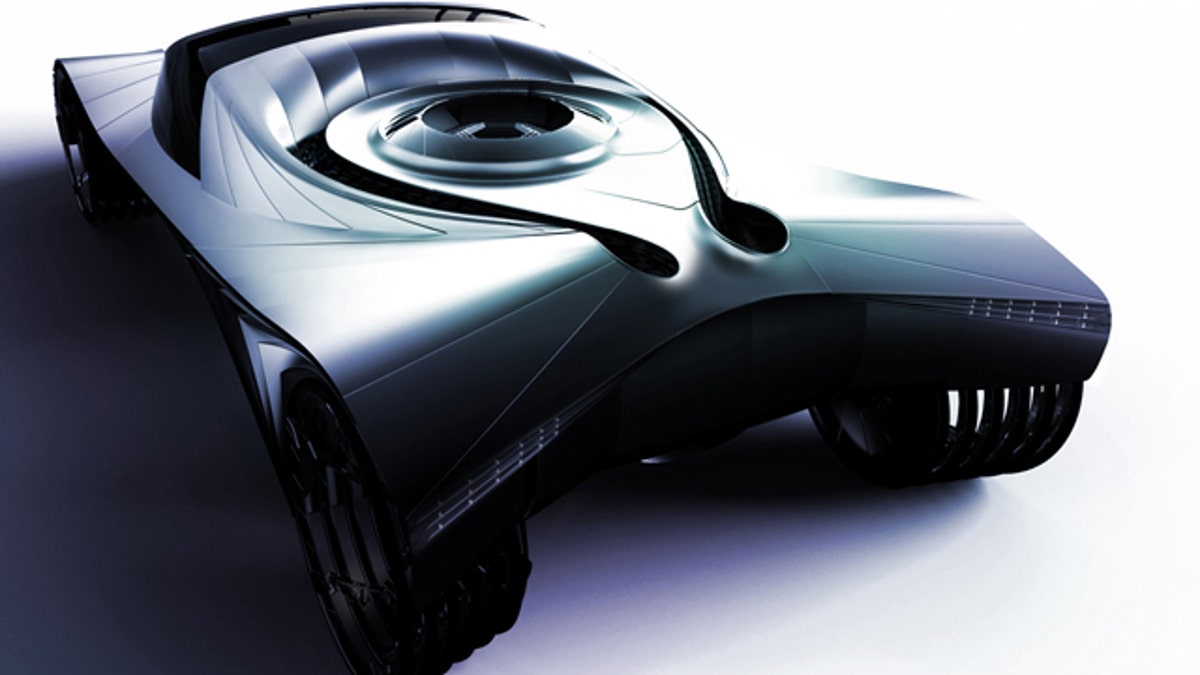
(Lorus Kulesus)
In 2009, artist Lorus Kulesus unveiled designs for a sleek, aerodynamic roadster with a striking front grill and massive “tires” made up of 24 separate wheels stacked together in four groups.
Christened the Cadillac World Thorium Fuel Concept – in tribute to Caddy’s 100th anniversary as part of General Motors - as its name implied, the car would be powered by thorium, a mildly radioactive element found in rocks that’s in great abundance. It was as if Dr. Emmett Brown's Mr. Fusion from the film "Back to the Future" had finally become a reality.
Sadly, Kulesus hadn’t actually invented a thorium engine that worked – it was purely a concept, but one with some merit.
Unlike uranium or plutonium, thorium is sub-critical. You can hold a rock laced with it in your hand with no harm done, so putting it in a vehicle isn't out of the question.
Now, Laser Power Systems, a small R&D start-up in Connecticut, has announced a new design for a thorium engine that could be used in a future car. The idea is to provide engine power that’s cost-effective and perfectly safe for consumers.
Charles Stevens, Laser Power System's CEO and Chairman, told FoxNews.com that his design uses just eight grams of thorium to run...for years. The engine uses a laser that gets its energy from the decaying material to produce steam for an on-board turbine that runs a generator to power electric motors. The exact specifications for how this would work are still under wraps.
Stevens says just one gram of thorium would provide the equivalent of 7,500 gallons of gasoline, so a thorium-powered car could last for 300,000 miles or 5,000 hours of driving between fill-ups, by his calculations.
Further, the 200-250kW (268-335 horsepower) thorium engine would last for the typical life of a car. Most owners would never need to refuel and, for those in it for the very long haul, an engine swap complete with fresh thorium could be done at a dealer for a few thousand dollars, Stevens says.
NASA uses a similar concept to power exploratory spacecraft like New Horizons, which will reach Pluto in 2015 after a 9-year journey. That radioactive material has a major advantage for interplanetary travel: the decaying matter generates a small amount of energy over a very long period of time, lasting for decades. (NASA uses plutonium not thorium – the plutonium charges metal strips to generate the electricity, without lasers or steam.)
Stevens acknowledges that his project is in an early stage. Automakers are extremely cautious about new alternative fuels, and he’s incredulous about government involvement. “It’s easier to get billions to do stupid stuff [than] a few hundred million to do really smart stuff,” he says.
But is a nuclear car possible?
The Laser Power Systems design is unique in that it does not generate a nuclear reaction. Calling it a “nuclear car” isn’t exactly accurate, although the radioactive material is used to generate heat.
Last month, Wards Auto quoted a senior advisor to the US Geological Survey that the thorium car is both plausible and sensible. A chart showed the ready availability of thorium.
In late August, Txchnologist, an online magazine sponsored by General Electric, detailed a description of how the thorium engine would work. However, the thorium-powered car is suspect, say experts who spoke to FoxNews.com.
FoxNews.com Autos is on Twitter. Follow us @foxcarreport
“I can't say for sure that it's not true, especially since [Mr. Stevens] hasn't put out any papers on it or described exactly what he's doing, but I have a lot of serious reservations. The physics just don't work out,” says Stephen Granade, a PhD physicist with Advanced Optical Systems.
Granade, who understood that the Laser Power Systems invention would not use a nuclear reaction, but would use a thorium-powered laser to spin a turbine, said it’s still not possible.
"The process needs to be 50 times more energy efficient than nuclear fission for one gram of thorium to be equivalent to 7,500 gallons of gas," Granade says.
Edwin Lyman, a nuclear physicist with the Union of Concerned Scientists, an organization that evaluates nuclear power safety conditions, told FoxNews.com that the nuclear car and the thorium engine is just not possible unless it involves heat from the decaying matter.
Click here for more from FoxNews.com Autos
Told that Stevens will not generate heat using a nuclear reaction, Lyman still said the physics of the engine do not make sense because the intent is still to use the decaying matter. The power needs to be generated somehow – lasers do not create their own power. If it is from decaying matter, Lyman says a vehicle with a 300,000-mile range would need 100 million times as much thorium as plutonium – or a billion tons.
Deborah Gordon, a chemical engineer and analyst from the Carnegie Endowment for International Peace who focuses on transportation innovations, told FoxNews.com that a thorium engine would generate an incredible amount of waste. The engine would be inefficient, she says, because of the loss of thermal energy. She also says it can take a half-century or longer for any new engine innovation as dramatic as the thorium car to make any headway in the United States.
Not every scientist was quite so incredulous, however.
Lord Cole, a UCLA Aerospace Engineering PhD candidate, says thorium could be used as a breeder fuel in cars, and there is serious work underway to use the chemical as a new kind of nuclear energy.
“If a beam of thorium could be effectively directed toward a working fluid, analogous to a steam locomotive boiler, it would be feasible to have a gas turbine engine, but not necessarily practical. The size, weight, and operating temperatures of a thorium-powered engine are a design challenge.”
A century ago steam-powered cars were as popular as ones that ran on gasoline. If Stevens can prove that his engine works, we could be headed back to the future.